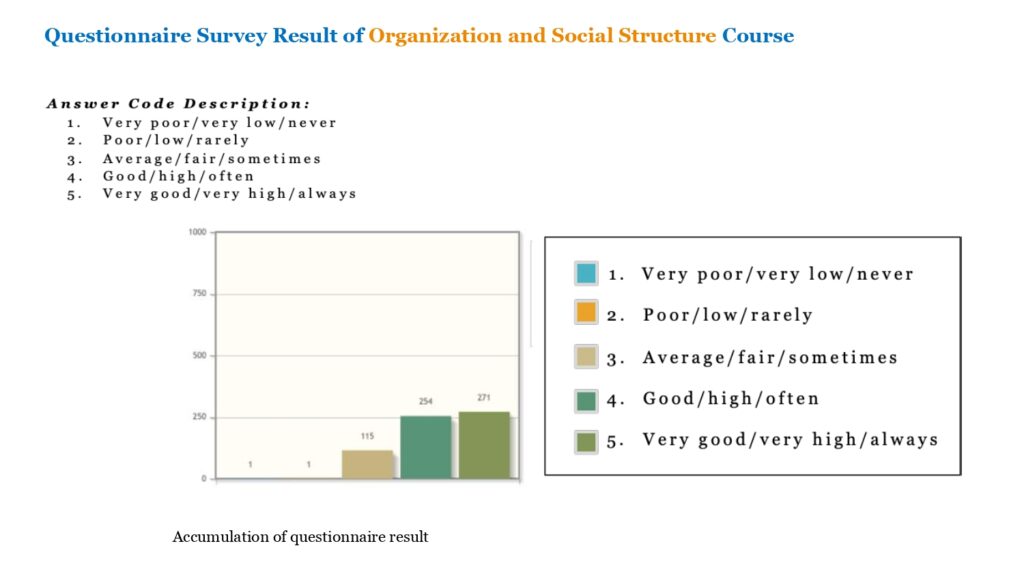Organization and Social Structure
Overview
Course Code
ANT62147
Credits
2
Semester
II
Frequency
Even
Type
General Course
Class Size
30
Duration
16 meetings
Student Workload
80 hours
Contact Hours
23 hours
Independent Study
28 hours
Description
Social structure and organization encompasses all aspects of society, the economy and even our personal lives. As human beings, we are directly involved in these social structures and organizations from the beginning, starting with the family. We may be born in a hospital, and we may be buried by a funeral society. The school that educates us is an organization, as is the store where we buy our food, the company that makes our car, and the people who collect income tax, collect garbage, and so on. The social structure and organization course is then held to deeply study and critically analyze the closest thing to our daily lives as individuals and societies.
Course Content
- Establishment of Social organization and structure.
- Organization and stratification.
- Keluarga sebagai sebuah organisasi dan struktur sosial.
- Power and social capital.
- Social Network Analysis.
- Organization theory.
- Types of organizations and social structures.
Reference
Primary Literature
- Keesing Roger, Felix M. Keesing (1971) New perspectives in cultural anthropology /New York: Holt, Rinchart and Winston.
- Gibson, J. L., & John Ivancevich, J. D. (2009). Organizations: Behaviour Structure, Processes. New York: McGraw.
- Elster, J., & Hernes, G. (1986). Stratification and Organization. Cambridge: Cambridge University Press.
- Folbre, N., & Bittman, M. (2004). The Social Organization of Care. London: Routledge.
- Islam, M. S. (2008). Power in Social Organization. Bangladesh e-Journal of Sociology. Vol.5, No.1 , 1-21.
Supporting Literature
- Ghoshal, J. N. (1998). Social Capital, Intellectual Capital, and the Organizational Advantage. The Academy of Management Review. Vol. 23, No. 2, 242-266.
- Noel M. Tichy, M. L., & Fombrun, C. (1979). Social Network Analysis for Organizations. The Academy of Management Review. Vol. 4, No. 4, 507-519.
- Caris, C & Reysnolds S. (2014). Isis Governance in Syria. Institute for the Study of War.
- Scott, J. C. (1972). Patron-Client Politics and Political Change in Southeast Asia. The American Political Science Review, Vol. 66, No. 1, 91-113.
- Li, T. M. (2007). Govermentality. Anthropologica, Vol. 49, No. 2, 275-281.
- Gilliespie, S. D. (2000). Rethinking Ancient Maya Social Organization: Replacing “Lineage” with “House”. American Anthropologist, 467-484.
- Browning, C. R., Feinberg, S., & Dietz, R. D. (2004). The Paradox of Social Organization: Networks, Collective Efficacy, and Violent Crime in Urban Neighborhood. Social Justice, 503-534.
Assessment System
Assessment Matrix
- attitude 10%
- Participation 40%
- Assignment 10%
- Quiz 10%
- Midterm Exam 15%
- Final Exam 15%
- Peer-Assessment
Peer-Assessment
The percentage of student contribution is taken from the score given by group members to other group members (peer-assessment) regarding the contribution in the process of working on the task from beginning to end.
- Score 100% if the assessed member fully participates from start to finish
- Score 75% if the assessed member participates actively, although sometimes less involved
- Score 50% if the assessed member participates, although often not involved
- Score 25% if the assessed member only appears at the beginning/middle/end only
- Score 0% if the assessed member is not involved at all
- The student contribution percentage score is the total number of peer-assessments divided by the number of group members who were assessed
Students Feedback


